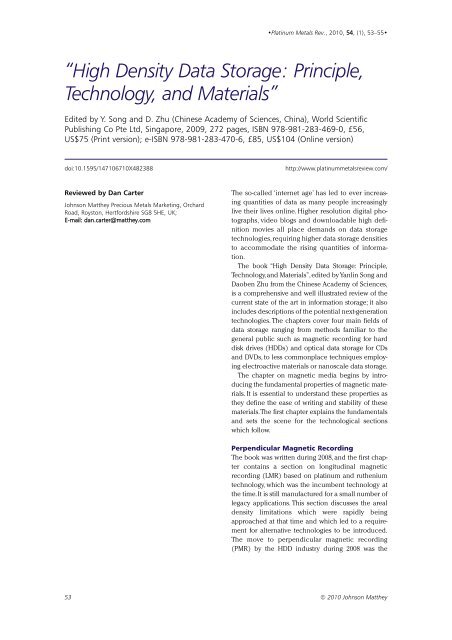Download Issue PDF - Platinum Metals Review
Download Issue PDF - Platinum Metals Review
Download Issue PDF - Platinum Metals Review
You also want an ePaper? Increase the reach of your titles
YUMPU automatically turns print PDFs into web optimized ePapers that Google loves.
•<strong>Platinum</strong> <strong>Metals</strong> Rev., 2010, 54, (1), 53–55•<br />
“High Density Data Storage: Principle,<br />
Technology, and Materials”<br />
Edited by Y. Song and D. Zhu (Chinese Academy of Sciences, China), World Scientific<br />
Publishing Co Pte Ltd, Singapore, 2009, 272 pages, ISBN 978-981-283-469-0, £56,<br />
US$75 (Print version); e-ISBN 978-981-283-470-6, £85, US$104 (Online version)<br />
doi:10.1595/147106710X482388<br />
http://www.platinummetalsreview.com/<br />
<strong>Review</strong>ed by Dan Carter<br />
Johnson Matthey Precious <strong>Metals</strong> Marketing, Orchard<br />
Road, Royston, Hertfordshire SG8 5HE, UK;<br />
E-mail: dan.carter@matthey.com<br />
The so-called ‘internet age’ has led to ever increasing<br />
quantities of data as many people increasingly<br />
live their lives online. Higher resolution digital photographs,<br />
video blogs and downloadable high definition<br />
movies all place demands on data storage<br />
technologies,requiring higher data storage densities<br />
to accommodate the rising quantities of information.<br />
The book “High Density Data Storage: Principle,<br />
Technology,and Materials”,edited by Yanlin Song and<br />
Daoben Zhu from the Chinese Academy of Sciences,<br />
is a comprehensive and well illustrated review of the<br />
current state of the art in information storage; it also<br />
includes descriptions of the potential next-generation<br />
technologies. The chapters cover four main fields of<br />
data storage ranging from methods familiar to the<br />
general public such as magnetic recording for hard<br />
disk drives (HDDs) and optical data storage for CDs<br />
and DVDs, to less commonplace techniques employing<br />
electroactive materials or nanoscale data storage.<br />
The chapter on magnetic media begins by introducing<br />
the fundamental properties of magnetic materials.<br />
It is essential to understand these properties as<br />
they define the ease of writing and stability of these<br />
materials.The first chapter explains the fundamentals<br />
and sets the scene for the technological sections<br />
which follow.<br />
Perpendicular Magnetic Recording<br />
The book was written during 2008, and the first chapter<br />
contains a section on longitudinal magnetic<br />
recording (LMR) based on platinum and ruthenium<br />
technology, which was the incumbent technology at<br />
the time.It is still manufactured for a small number of<br />
legacy applications. This section discusses the areal<br />
density limitations which were rapidly being<br />
approached at that time and which led to a requirement<br />
for alternative technologies to be introduced.<br />
The move to perpendicular magnetic recording<br />
(PMR) by the HDD industry during 2008 was the<br />
53 © 2010 Johnson Matthey
















